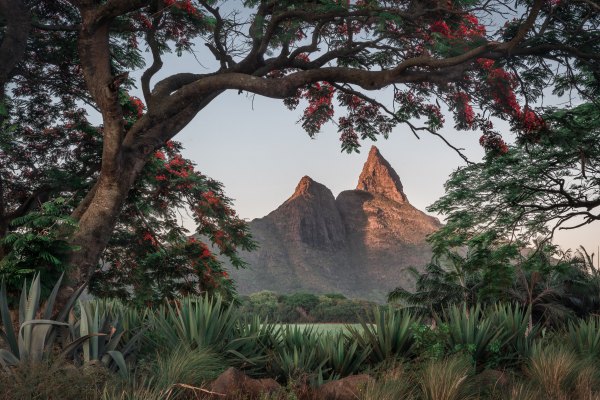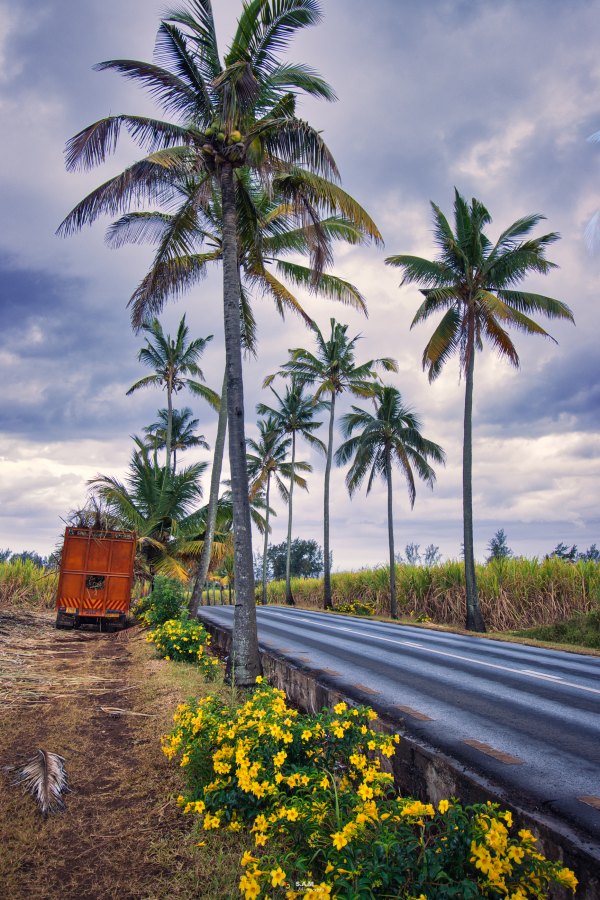Exploring the Enchanting Trees of Mauritius
Read moreThe Rich Tapestry of Trees in Mauritius: From Iconic Flamboyants to Conservation Efforts
Introduction
Mauritius, an island nation nestled in the Indian Ocean, boasts a remarkable biodiversity, including a captivating array of trees. From the famous Flamboyant tree that dots the landscape with its vibrant red blooms to the numerous fruit trees such as the Mango, Lychee, and Banana trees, the island is a botanical paradise. However, as with any ecosystem, there are both desirable and undesirable tree species, and Mauritius has had its share of deforestation challenges since its discovery. Nevertheless, the preservation of trees has become a paramount concern, with organizations like the Mauritius Wildlife Foundation leading efforts to protect the island's rich flora and combat deforestation.
The Famous Flamboyant Tree
The Flamboyant tree (Delonix regia) holds a cherished place in the hearts of Mauritians and visitors alike. With its striking fiery red or orange flowers, the tree adds a touch of splendor to the island's landscapes. Originally from Madagascar, the Flamboyant tree has adapted well to Mauritius' tropical climate. It typically blooms during the summer months, carpeting the surroundings with its brilliant hues. The Flamboyant's broad, umbrella-like crown provides ample shade, making it a popular choice for roadside plantings, gardens, and parks. This iconic tree is not only visually captivating but also symbolizes resilience and vitality, reflecting the spirit of the Mauritian people.
Coconut & Palm Trees
Coconut trees (Cocos nucifera) are a familiar sight along the coastlines of Mauritius. These tall and graceful trees with their slender trunks and feathery fronds evoke images of serene beaches and swaying hammocks. The coconuts produced by these trees are highly versatile and have been an essential resource for the local population for centuries.
The coconut itself is a valuable fruit, used in various culinary preparations and refreshing beverages. It is also a source of coconut oil, which is widely used in cooking, skincare, and hair care products. In addition to the fruit, the leaves, husks, and trunks of the coconut tree have practical uses. The leaves are woven into thatch for traditional roofing, and the husks are used as natural fibers for making ropes, mats, and handicrafts. The sturdy trunks are utilized for construction purposes, providing timber and durable wood.
Palm trees, including the iconic Royal Palm (Roystonea regia), are another prominent feature of Mauritius' landscapes. With their tall and straight trunks topped by a crown of large, fan-shaped leaves, these trees exude elegance and grandeur. The Royal Palm, in particular, is highly valued for its ornamental qualities and is often used in landscaping to create a luxurious and tropical ambiance.
Palm trees, like coconut trees, offer multiple benefits beyond their aesthetic appeal. They bear fruit, such as the Date Palm (Phoenix dactylifera), which provides a delicious and nutritious treat. The leaves of certain palm species are used to create handicrafts, baskets, and even roofing materials. The trunks, rich in cellulose, can be processed into biofuels, offering a renewable energy source.
Apart from their practical uses, coconut and palm trees play a significant role in the island's ecosystem. They provide shade and shelter for other plant species, creating microhabitats that support a diverse range of flora and fauna. The fallen fronds and decaying organic matter from these trees contribute to nutrient cycling and soil fertility. Moreover, the extensive root systems of palm trees help prevent soil erosion, preserving the integrity of coastal landscapes more particularly at resorts in Mauritius.
While coconut and palm trees are cherished for their beauty and utility, they are not immune to the threats that face Mauritius' trees as a whole. Deforestation, invasive species, and climate change pose challenges to their survival. Efforts are being made to protect and conserve these iconic trees through sustainable land management practices, reforestation projects, and the enforcement of conservation regulations.
Fruit Trees in Mauritius
Mauritius is blessed with an abundance of fruit trees, which contribute to the island's vibrant culinary culture and agricultural heritage.
- Mango trees (Mangifera indica) are particularly prevalent and produce a variety of delicious mango cultivars, delighting locals and tourists alike.
- The Lychee tree (Litchi chinensis) is another cherished fruit-bearing tree, offering juicy, translucent fruits with a delicate flavor.
- The Longan tree (Dimocarpus longan), often referred to as the "dragon's eye," bears small, round fruits with a sweet and succulent taste.
- Banana trees are a common sight across the island, with their lush foliage and bunches of ripening fruit.
- The Jackfruit tree (Artocarpus heterophyllus) is notable for its enormous size and produces large, green, and spiky fruits with a sweet and distinctive flavor. These fruit trees not only provide sustenance but also contribute to the local economy, as Mauritius exports a significant quantity of tropical fruits.
Undesirable Trees
While Mauritius boasts a rich tree diversity, there are also species that pose significant threats to the island's delicate ecosystem. One such example is the invasive Guava tree (Psidium guajava), which has rapidly spread across the island. Guava trees are highly adaptable and can outcompete native species, impacting biodiversity and ecosystem stability. Similarly, the invasive Acacia species, such as Acacia mearnsii and Acacia saligna, have established themselves on the island and pose a threat to native flora. Efforts are underway to control these invasive species and prevent their further spread.
Indigenous Trees
Mauritius is a haven for indigenous tree species, some of which are found nowhere else on Earth. These trees have evolved in isolation and have adapted to the island's unique ecosystems. One notable example is the Bois d'Ébène (Diospyros spp.), a tree highly valued for its dense, dark wood. Historically, the Bois d'Ébène played a significant role in Mauritius' history, as it was heavily exploited during the early years of colonization. Today, efforts are underway to protect and restore populations of this iconic tree.
Another remarkable indigenous species is the Bois de Natte (Labourdonnaisia calophylla), a slow-growing tree with a distinctive umbrella-shaped crown. The tree's leaves were traditionally used by the island's inhabitants for thatching roofs and weaving baskets. The Bois de Natte is now protected, and conservation initiatives aim to conserve its population.
The Tambalacoque (Sideroxylon grandiflorum), also known as the Dodo tree, holds great historical and ecological significance. It was once believed that the Tambalacoque was on the verge of extinction, as it only produced seedlings in the presence of the now-extinct dodo bird. However, recent studies have challenged this theory, and efforts to protect and propagate the Tambalacoque continue.
These indigenous trees, along with many others such as the Bois de Rempart (Mimusops balata) and Bois Chandelle (Dracaena concinna), are essential components of Mauritius' fragile ecosystems. Their preservation is vital for the conservation of biodiversity and the maintenance of ecological balance.
Deforestation in Mauritius
Since its discovery in the 16th century, Mauritius has faced significant deforestation challenges. The arrival of humans brought the need for land for agriculture, settlements, and timber. This led to widespread clearing of forests, resulting in the loss of indigenous tree species and their associated habitats.
One of the most devastating periods of deforestation occurred during the colonial era, particularly in the 18th and 19th centuries. The need for timber to fuel the sugar industry, which was the backbone of the Mauritian economy, led to extensive clearing of forests. Native trees, including valuable species such as the Bois d'Ébène, were harvested at an unsustainable rate. As a consequence, vast tracts of natural forests were lost, leading to soil erosion, loss of biodiversity, and a decline in ecosystem services.
The impacts of deforestation were far-reaching. The loss of forests disrupted waterfalls and watersheds, affecting water availability and quality. Soil erosion intensified, leading to increased sedimentation in rivers and coral reefs, negatively impacting marine ecosystems. Additionally, the loss of habitat contributed to the decline of numerous plant and animal species, including endemic and endangered species.
The Preservation of Trees by the Mauritius Wildlife Foundation
Recognizing the importance of preserving trees and protecting the island's unique biodiversity, the Mauritius Wildlife Foundation (MWF) has been at the forefront of conservation efforts. Founded in 1984, the MWF focuses on various initiatives to protect and restore Mauritius' natural heritage.
The MWF plays a crucial role in habitat restoration, including reforestation projects aimed at regenerating native forests. Through these efforts, indigenous tree species are reintroduced, helping to revive degraded ecosystems and provide habitat for threatened species. These projects also involve engaging local communities, raising awareness about the importance of tree conservation and encouraging sustainable land management practices. In addition to habitat restoration, the MWF emphasizes the control of invasive species that pose a threat to native trees and ecosystems.




































































































































































































































































































































































